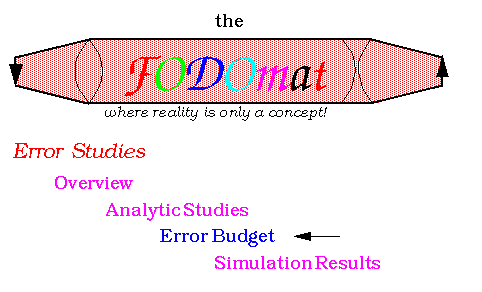
A detailed error budget has been developed using the analytic treatment of error effects in the driver accelerator. As the beam can fill as much as one third to one half of the machine physical aperture (typically 5 cm x 5 cm to 15 cm x 5 cm in magnets and 7 cm x 7 cm in cavities) during energy recovery, we require that beam growth due to all error sources be limited to the order of 10% of the nominal beam spot size. Analysis of the effect of any single error source is then used to set engineering tolerances that insure beam quality degradation from the sole error be limited to the 0.1-1% range. A sum in quadrature over all errors will then be limited as desired.
Typical beamline error tolerances are presented in the following table. Dipole and quadrupole alignment tolerances are a factor of two looser than in the CEBAF transport system. Because of the large bend angles and relatively short focal lengths used in this system, excitation tolerances are consistent with or a factor of a few tighter than in CEBAF. These features, together with very large beam sizes, lead to magnetic field quality specifications that are (in the dipoles) considerably tighter than in CEBAF.
| ERROR SOURCE | TOLERANCE | REMARKS |
|---|---|---|
| Misalignment -transverse | ||
| dipole | 1 mm | rms |
| quadrupole | 0.5 mm | rms |
| Misalignment -longitudinal | ||
| position | 1.25 mm | rms |
| roll | 1 mrad | rms |
| Excitation -DC | ||
| pi-bend - excitation | 0.00025 | rms relative error in field/field integral |
| pi-bend - reproducibility | 0.0001 | rms relative field error in sequence of setpoints |
| reverse/chicane bends - excitation | 0.001 | rms relative field in field/field integral |
| reverse/chicane bends - reproducibility | 0.0001 | rms relative field error in sequence of setpoints |
| quadrupoles - excitation | 0.0005 | rms gradient error relative to design |
| quadrupoles - reproducibility | 0.0005 | rms relative gradient variation in sequence of set points |
| Excitation -AC | ||
| main dipoles | 0.00001 | rms regulation; dipoles powered in series |
| quadrupole | 0.0001 | rms regulation; |
| Magnetic Field Quality | ||
| dipole end field | K1=0.27+/- 0.05 | end field rolloff integral |
| dipole body field - gradient error | 0.875 gauss | rms allowed gradient integral error at 42 MeV |
| dipole body field - nonlinear variation | ðB/B< 10-4 | allowed nonlinear relative field variation across working aperture at any point along orbit |
| quadrupole - systematic multipoles | ðB/B< 10-3 | allowed poletip field error due to any systematic multipole |
| quadrupole - random multipoles | ðB/B< 10-3 | total allowed field error at half aperture due to all random multipoles |
These values are representative of error tolerances in the FEL Demo Driver. We comment that the AC dipole excitation tolerances are established for dipoles powered in series. Such a scheme utilizes the achromatic and/or isochronous nature of the transport system to suppress ripple-driven beam motion (the time scale of such motions being several orders of magnitude slower than the circulation frequency of the machine) and thereby relax the tolerance by at least an order of magnitude. Were the dipoles individually powered, regulation at 1 ppm would be needed.
DC orbit errors due to variations amongst individual and grouped
dipole magnets are avoided by appropriate specification of allowable field
errors and by the selective use of shunts. The optical cavity chicanes
will be driven by a single power supply; the downstream chicane will
be shunted below the upstream to allow for before/after lasing energy
centroid offsets. All recirculation arc dipoles will be powered in
series; the pi-bends will be individually shunted to allow correction
of excitation errors relative to the reverse bends and each other.
In all cases, the product of shunt range and regulation is at the
10-6 level, to meet the aforementioned
tolerance on excitation of individual dipoles.
| Project Overview | |
| System Design Process | |
| Application of Process to High Power IR FEL | |
| Description of Solution | |
| System Performance | |
| Error Studies | |
| A. Overview | |
| B. Analytic Studies | |
| **you are here! ** | C. Error Budget |
| **the next link is | D. Simulation Results |
| Upgrade Scenarios | |
| | |
| Go to The FODOmat's FEL Page | |
Last modified: 10 March 1997
http://www.jlab.org/~douglas/
is maintained by: douglas@jlab.org